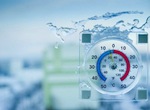 We are being asked a lot lately about obligations in relation to cold working conditions. This can be a serious issue outdoors in Australia this time of year for some, but also relevant to work in freezer plants and cold storage facilities at any other time. We know the main issues associated with tissue damage, such as frostbite and chilblains, but probably more applicable to us in the Australian climate is that severe cold can impede nerve reactions as fingers and hands lose dexterity, thus presenting other significant hazards.
We are being asked a lot lately about obligations in relation to cold working conditions. This can be a serious issue outdoors in Australia this time of year for some, but also relevant to work in freezer plants and cold storage facilities at any other time. We know the main issues associated with tissue damage, such as frostbite and chilblains, but probably more applicable to us in the Australian climate is that severe cold can impede nerve reactions as fingers and hands lose dexterity, thus presenting other significant hazards.
6 simple and practical ways for business owners, managers and contractors to manage cold working conditions safely. This includes temperature assessment, the provision of workplace heating, protective clothing, training, and health assessments.
Organisations need to ensure the workplace environment is maintained above an adequate temperature level, so as to prevent thermal stress of personnel and provide them with an adequate level of comfort.
1. Conduct assessments of cold working conditions
The minimum temperature at each work location should be assessed and monitored to determine whether personnel may be exposed to extremes of cold conditions.
The measurement and monitoring should be carried out for a range of weather conditions (including at night and early in the morning), to ensure all possible conditions have been covered.
2. Consider control measures
The application of control measures should follow the organisations hierarchy of control principles.
Where required, the option of removing personnel from the source of cold should be considered before any other measures are taken.
Where required, heating arrangements, (e.g. electric heaters, fuel heaters, central heating, etc.), should be considered.
Where cold conditions cannot be completely eliminated, Personal Protective clothing should be used.
In addition, the following suggested specific measures should be incorporated into operating procedures for work in cold conditions, as appropriate:
Do not allow bare skin to come into contact with cold surfaces below -7°C, especially surfaces made of materials that are good conductors of heat, e.g. metals.
Do not allow bare skin to come into contact with evaporative liquids, e.g. petrol, cleaning fluids, alcohol.
Do not remain still for a long time.
Do not consume alcohol.
For warming purposes, supply hot non-alcoholic drinks. Limit caffeine consumption as it increases urine production and blood circulation – both increase the loss of body heat.
Encourage the restriction of tobacco consumption.
Encourage personnel to eat adequate food frequently.
Encourage personnel to drink plenty of water to re-hydrate.
In refrigerated rooms, keep air speed < 1 m/sec where possible.
All work in cold conditions should be under constant observation (through a buddy system or supervision).
New employees and workers should not be required to work full-time in the cold until they have become accustomed to the conditions and the personal protective clothing they need to wear.
Consider applying lip balm and moisturising lotions to prevent lesions.
Encourage personnel to maintain a high level of fitness.
If a worker cannot be adequately protected from the effects of cold, then work must be suspended, or work regimes modified, to remove the risk of harm.
3. Develop your team
Personnel who may be exposed to extremely cold conditions should receive training in the symptoms of thermal stress and first aid treatment.
4. Monitor health
Personnel who are required to work in locations of extremely cold conditions should undergo a health assessment.
5. Check and maintain heating systems
Heating systems that may present a biological hazard (e.g., Legionnaires Disease), should be regularly checked and maintained.
6. Develop emergency protocols for work in cold rooms
Cold rooms, blast chillers and freezing chambers should be fitted with appropriate emergency equipment, signalling devices, lighting and exit doors which are identifiable in the event of a power failure. Exits should also be kept clear at all times and opened from the inside.
Personnel who are required to work in cold rooms should be trained in emergency procedures and the use of emergency equipment. Man down alarms are also useful tools in this environment.
Put yourself in the shoes of the people doing the work. Consider what they have to touch, see, hear and feel to be safe and as comfortable as possible to achieve the desired outcomes of the tasks involved.
Remember its managers and supervisors who can change the system of work! Your people need to know (from you) that they can raise issues of safety with you without fear of any repercussion.


